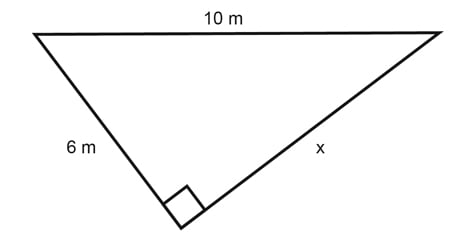
Basic Geometry Practice Questions with Full Answer Key – Area, Perimeter, Volume & Angles
- Posted by Brian Stocker MA
- Date April 3, 2014
- Comments 18 comments
High School geometry questions similar to what you will find on a standardized test.
Geometry Practice Test
1. What is measurement of the indicated angle assuming the figure is a square?
a. 45o
b. 90o
c. 60o
d. 30o
2. What is the sum of all the angles in the rectangle above?
a. 180o
b. 360o
c. 90o
d. 120o
3. What is the measurement of the indicated angle?
a. 45o
b. 90o
c. 60o
d. 50o
4. If the line m is parallel to the side AB of ?ABC, what is angle a?
a. 130o
b. 25o
c. 65o
d. 50o
5. What is perimeter of the above shape?
a. 12 cm
b. 16 cm
c. 6 cm
d. 20 cm
6. What is (area of large circle) – (area of small circle) in the figure above?
a. 8 п cm2
b. 10 п cm2
c. 12 п cm2
d. 16 п cm2
7. What is perimeter of ?ABC in the above shape?
- 25.5 cm
- 27 cm
- 30 cm
- 29 cm
8. What is the volume of the figure above?
a. 125 cm3
b. 875 cm3
c. 1000 cm3
d. 500 cm3
9. What is the volume of the above solid made by a hollow cylinder with half in size of the larger cylinder?
a. 1440 п in3
b. 1260 п in3
c. 1040 п in3
d. 960 п in3
Answer Key
1. B
The diagonals of a square intersect perpendicularly with each other so each angle measures 90o
x =90o
2. B
a+b+c+d = ?
The sum of angles around a point is 360o a+b+c+d = 360o
Video Solution
3. C
The sum of angles around a point is 360o
d+300 = 360o
d = 60o
Video Solution
4. D
Two parallel lines(m & side AB) intersected by side AC
a= 50o (interior angles)
5. B
The square with 2 cm side common to the rectangle apart from 4cm side
Perimeter = 2+2+2+4+2+4 = 16 cm
6. C
In the figure, we are given a large circle and a small circle inside it;
with the diameter equal to the radius of the large one. The diameter of the
small circle is 4 cm. This means that its radius is 2 cm. Since the diameter
of the small circle is the radius of the large circle, the radius of the large
circle is 4 cm. The area of a circle is calculated by: пr2 where r is the
radius. Area of the small circle: п(2)2 = 4п Area of the large circle: п(4)22 = 16п
The difference area is found by:
Area of the large circle – Area of the small circle = 16п – 4п = 12п
7. D
Perimeter of a shape with two squares and triangle ABC.
Perimeter = 8.5+8.5+6+6
Perimeter = 29 cm.
8. C
Large cube is made up of 8 smaller cubes of 5 cm sides.
Volume = Volume of small cube x 8
Volume = (5 x 5 x 5) x 8, 125 x 8
Volume = 1000cm3
9. B
Volume= Volume of large cylinder – Volume of small cylinder
(Volume of cylinder = area of base x height)
We know the small cylinder is 1/2 the size of the large cylinder
So, Volume of the small cylinder
= Large Cylinder (п 122x 10) – Small Cylinder(п 62x 5)
= 1440п – 180п
Volume of small cylinder = 1260п in3
Most Popular Geometry Questions
Common geometry questions on on standardized tests :
- Solve for the missing angle or side
- Finding the area or perimeter of different shapes (e.g. triangles, rectangles, circles)
- Problems using the Pythagorean Theorem
- Calculate properties of geometric shapes such as angles, right angles or parallel sides
- Calculating volume or surface area of complex shapes for example spheres, cylinders or cones
- Solve geometric transformations such as rotation, translation or reflections
Most Common Geometry Mistakes on a Test
- Not clearly labeling or identifying the given and unknown information in a problem
- Not understanding the properties and definitions of basic geometric figures (e.g. line, angle, triangle, etc.)
- Incorrectly using basic formulas (e.g. area of a triangle, Pythagorean theorem)
- Incorrectly interpreting geometric diagrams
- Not understanding the relationship between parallel lines and transversals
- Not understanding the relationship between angles and their degree measures
- Not understanding the relationship between perimeter and area
Date Published: Thursday, April 3rd, 2014
Date Modified: Tuesday, June 18th, 2024
You may also like

Basic Math Video Tutorials

How to Answer Basic Math Multiple Choice
How to Solve Linear Inequalities – Quick Review and Practice
Basic linear inequalities have one of the following forms: ax + b > 0 ax + b < 0 ax + b > 0 ax + b < 0 where a and b are some real numbers. Our solution to …










18 Comments
answer to question five should be 18, you forgot to include the 2cm outer side of the rectangle
Divide the figure into a square and a rectangle – perimeter of the square – 3 X 2 = 6 note 3 sides are included in the perimeter. Upper rectangle 2 X 4 = 8 + 2 = 10 total perimeter = 10 + 6 = 16
Try again – the question asks for the PERIMITER – 3 sides of the square – 2 + 2 + 2 = 6; 2 sides of the rectangle – 4 + 4 = 8; 1 side of the rectangle (top) = 2
6 + 8 + 2 = 16
The line between the square and the rectangle isn’t counted for perimeter, perimeter is the amount of units around the OUTSIDE. Since the square and rectangle are connected, try thinking of them as one big rectangle and forget about the line in between.
Correct – the bottom square has 2 cm each side on 3 sides (2 + 2 + 2 = 6). The top rectangle has 2, 4 cm sides (4 + 4 = 8) and 1, 2 cm side. So the total is 6 + 8 + 2 = 16.
Please in no 6 ,42 -22 is 20,so how comes about 16 and how did u get 122 in no 10
The answers are correct – I have updated and expanded the solutions – also the п symbol wasn’t displaying properly – thanks!
102°-2x +78°=180°
Love this. Super helpful!
In #9, since it is a cylinder; shouldn’t you use Pi in calculating the area of the base??
hi – yes the answer does use pi – the web rendering is a little funny tho – looks like an ‘n’ but is is pi – e. g. Volume= (п 122x 10) – (п 62x 5), 1440? – 180п
in question #9 what is the formula of a cylinder if the diameter is given and not the radius?
I understand how you got the answer in question 5, however the way it is displayed is unclear.
It is not clear that the number 4 is attached to just the rectangle and not to the line as a whole.
This means there are two interpretations of the figure.
1) 4*2+2*2 = 12
2) 2(4+2) + 2*2 = 16
Thanks! this was super helpful!
Can you explain the question, the question isn’t asked properly. They are asking the volume made by the small cylinder, but the answer is solved for the remaining volume removing the small cylinder volume.
Not quite – the small cylinder is 1/2 the size of the larger cylinder, so Large Cylinder – Small Cylinder = Size of Small Cylinder. I have updated the answer explanation.
Tahnk you for all the wonderful explanations and answers
I don’t really understand how to use this website
But it look like a useful website to study